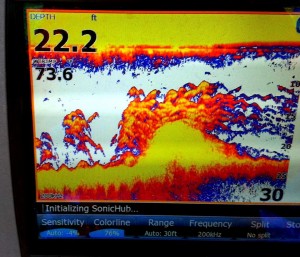chesapeake bay
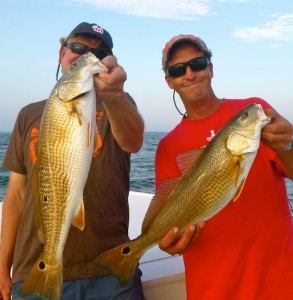 “If redfish keep biting like this, they can have the stripers!”
“If redfish keep biting like this, they can have the stripers!”
That’s a phrase I’ve heard more than once from Chesapeake Bay fishermen this year. I’ve been catching a few smallish reds around the Kent Island shoreline since May, but things have really opened up in the last week or so. Where are they and why are they here? I’ll tell you where later, but first let’s talk about why. Simply put, conservation measures are allowing red drum to expand their range. Successful fishing for slot-size red drum (fish between 18- and 27-inches long) is completely dependent on the success of spawning over the past three years. There is quite a bit of variation in a redfish’s rate of growth. At one year old, redfish will range from 10- to 17-inches long, averaging 14 inches. At two years old, they will range from 18- to 24-inches long. At three years old, they will range from 20- to 28-inches long, weighing four to nine pounds. If the reds you’re catching are in the slot, chances are they’re from the 2010 or 2011 spawning class. By all accounts, those were good years. Here’s the rest of the story: Read More!
There’s nothing more exciting than drifting over an underwater hump and seeing the fishfinder light up with returns from big fish. I was a twinkle in my father’s eye in 1959 when Carl Lowrance and his sons revolutionized fishing with their Little Green Box. Things have changed a lot since then. There’s no doubt that a good fishfinder is an essential tool for successful fishing.
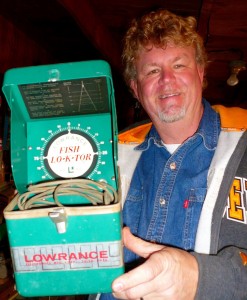 Just like with all fishing equipment there are many options to consider when it comes to choosing the right electronics for your angling arsenal. There’s been a lot written about the best units for off-shore fishing, and even more about fresh-water fishfinders, but I haven’t seen too much about the electronics that work best for light tackle fishing in the shallow, brackish waters of the Chesapeake Bay. Nothing beats experience in figuring out the essential bells and whistles of a good sonar unit. You can’t go wrong by hiring a guide and watching the way he or she uses her electronics. Since we’re in the business of shortening learning curves, here are ten tips to help you select the best light-tackle fishfinder for the Chesapeake Bay. Read More!
Just like with all fishing equipment there are many options to consider when it comes to choosing the right electronics for your angling arsenal. There’s been a lot written about the best units for off-shore fishing, and even more about fresh-water fishfinders, but I haven’t seen too much about the electronics that work best for light tackle fishing in the shallow, brackish waters of the Chesapeake Bay. Nothing beats experience in figuring out the essential bells and whistles of a good sonar unit. You can’t go wrong by hiring a guide and watching the way he or she uses her electronics. Since we’re in the business of shortening learning curves, here are ten tips to help you select the best light-tackle fishfinder for the Chesapeake Bay. Read More!
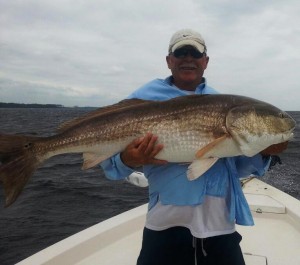 Hey, it’s summer and let’s face it, fishing is kind of mediocre. So, let’s have some fun! A very successful promotional campaign for a Mexican beer features a character called, “The Most Interesting Man In The World.” My choice for most interesting man in the world would have to be my regular fishing partner, Rich Jenkins. You’ve read some of my stories about his super-human exploits, and I can tell you a lot more over a cold drink or two. Surely, we all have someone we consider the most interesting man in the world, so I thought it would be interesting to jot down a few characteristics of the most interesting fisherMAN in the world. I thought of 30. Can you think of more?
Hey, it’s summer and let’s face it, fishing is kind of mediocre. So, let’s have some fun! A very successful promotional campaign for a Mexican beer features a character called, “The Most Interesting Man In The World.” My choice for most interesting man in the world would have to be my regular fishing partner, Rich Jenkins. You’ve read some of my stories about his super-human exploits, and I can tell you a lot more over a cold drink or two. Surely, we all have someone we consider the most interesting man in the world, so I thought it would be interesting to jot down a few characteristics of the most interesting fisherMAN in the world. I thought of 30. Can you think of more?
UPDATE: You can now follow The World’s Most Interesting Fisherman on Twitter. It’s @worldsfisherman or search #worldsmostinterestingfisherman. No, it’s not Rich Jenkins there, but it’s pretty darn funny!
1. Sharks have a week named after him.
2. Tidal currents stop and start moving again merely because he asks them to. Read More!
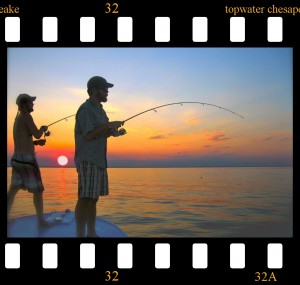 Lights! Action! Intensity! Get those video camera’s rolling. It’s time for adrenaline pumping surface action along the rocky shorelines and the grassy points of the Chesapeake Bay. The top-water bite is on! I’ve written a lot about where and when to cast top-water lures, but I haven’t said too much about choosing a good fishing rod for surface feeding stripers. Let’s fix that. Here are six tips for choosing the right top-water rod.
Lights! Action! Intensity! Get those video camera’s rolling. It’s time for adrenaline pumping surface action along the rocky shorelines and the grassy points of the Chesapeake Bay. The top-water bite is on! I’ve written a lot about where and when to cast top-water lures, but I haven’t said too much about choosing a good fishing rod for surface feeding stripers. Let’s fix that. Here are six tips for choosing the right top-water rod.
1. Spin It To Win It – Since it’s often windy on the Bay and surface lures are light and not very aerodynamic, I prefer a spinning outfit for top-water casting. There’s a trade off because casting rods are more accurate, but there’s nothing more frustrating than having to stop to pick out a backlash, especially while you’re drifting quickly past fish-holding cover. If need be, you can increase your accuracy with a spinning outfit by adding micro-guides, but standard guides work fine. Reduce your margin for error and go with the sissy stick. Read More!
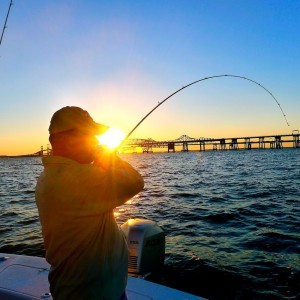 When it comes to selecting a rod, light tackle fishermen are rightfully very picky. Most of us get very specific about what we like. You’ll find several websites that have great information about choosing a multi-purpose fishing rod, but I don’t know of many that focus specifically on the best rods for casting lures on the Chesapeake Bay. There is always an element of personal choice when it comes to rod selection, and less experienced anglers should use basic and less-expensive equipment, but if you’re serious about the light tackle game, here are six things (and maybe a few more) you need to know:
When it comes to selecting a rod, light tackle fishermen are rightfully very picky. Most of us get very specific about what we like. You’ll find several websites that have great information about choosing a multi-purpose fishing rod, but I don’t know of many that focus specifically on the best rods for casting lures on the Chesapeake Bay. There is always an element of personal choice when it comes to rod selection, and less experienced anglers should use basic and less-expensive equipment, but if you’re serious about the light tackle game, here are six things (and maybe a few more) you need to know:
1. Baitcasting Benefits – Once you see a baitcaster used effectively for catching stripers, you’ll never go back to a spinning outfit. Baitcasters are appropriate for most jigging situations in the Chesapeake Bay. Wind and current can make a boat drift rapidly across a good jigging spot. As you drift across and away from the fish, your lure will be pulled up, over and above the strike zone. With a baitcaster, you simply press the thumb bar to let your lure fall back down to the proper depth. Unlike with a spinning reel, you don’t have to cast again. Keep in mind that, through most of the year, the bigger stripers are usually close to the bottom, so you increase your chances of catching them by keeping the lure where they are. Here’s a link to a video I shot in July a few years ago at the Bay Bridge. It shows some useful baitcasting techniques and includes some shots of resetting a lure into the strike zone. https://www.youtube.com/watch?v=sH_3rC0sZ-Y
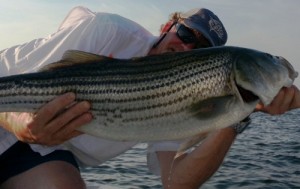 To share time-sensitive fishing information and relay real-time conditions on the water, I’ll be more active on Twitter. Last night at about 4:00 PM, I mentioned via Facebook that I would live-tweet a fishing trip starting at 5:30 PM. I’ll do this more often. Be assured that I won’t mention too many locations, but I’ll be specific about the patterns and techniques we encounter. I’ll also tweet pictures of the fish we’re catching, provide sonar shots, and share thoughts and details about hot lures and techniques. If you missed last night’s feed, you can read it on my Twitter page – @shawnkimbro. You can also follow me there to get the info live as it happens. I can’t do this all the time, but I’ll re-post last nights feed here, with some additional details and commentary inserted in italics. I’ve also cleaned up spelling and grammar since I use Google Voice instead of trying to type on my android touch-screen with wet hands. All the pictures (click the Twitter links) including the one to the left were tweeted live from the water.
To share time-sensitive fishing information and relay real-time conditions on the water, I’ll be more active on Twitter. Last night at about 4:00 PM, I mentioned via Facebook that I would live-tweet a fishing trip starting at 5:30 PM. I’ll do this more often. Be assured that I won’t mention too many locations, but I’ll be specific about the patterns and techniques we encounter. I’ll also tweet pictures of the fish we’re catching, provide sonar shots, and share thoughts and details about hot lures and techniques. If you missed last night’s feed, you can read it on my Twitter page – @shawnkimbro. You can also follow me there to get the info live as it happens. I can’t do this all the time, but I’ll re-post last nights feed here, with some additional details and commentary inserted in italics. I’ve also cleaned up spelling and grammar since I use Google Voice instead of trying to type on my android touch-screen with wet hands. All the pictures (click the Twitter links) including the one to the left were tweeted live from the water.
 Shawn Kimbro
Shawn Kimbro @ShawnKimbro 19h
Tweeting details of tonight’s fishing trip beginning 5:30 pm. #stormdodging
*I actually started a little earlier with a few preliminary details.



